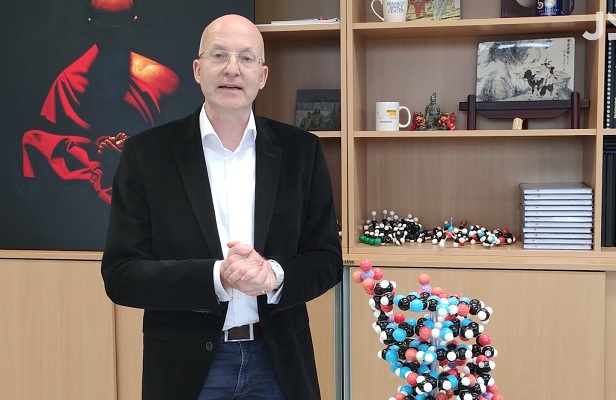A patent has now been granted in the USA for a molecular stamp developed by chemists at the JKU.

Prof. Brüggemann (Institute for Polymer Chemistry) introduced his new method during Materials Week organized by the Plastics Cluster of Upper Austria. Brüggemann explained that a wide variety of molecules can be used as tiny stamping dies, citing proteins (amino acids) and chimeras made of DNA and proteins (peptide nucleic acids) as examples.
All of their attributes - meaning their sequence - can be given a code such as, for example, a letter or a number. In addition, amino acids and many other molecules also have two mirror-inverted versions. This special "chiral" information is also stored in the matrix and later in the imprint.
Molecular embossing works by adding plastic molecules to this die template and allowing them to polymerize all around. The plastic then contains a negative form (complementary form) of the die that is stored within. Using non-toxic solvents, the die can be dissolved out again - in the simplest case with water – or, as the chemist explained, it can be left if the manufacturer prefers. The method could also be used to give metals and other substances a molecular code.
Brüggemann added: "You then have materials containing secret information that is not visible to the naked eye but can be chemically read at any time, providing you know the code. For example, in the case of a hit-and-run accident, you could find out the vehicle’s manufacturer and serial number by looking at tiny plastic samples taken from the bumper found at the scene. In this way, authorities could track the driver down."
Being able to read the information is, however, less sophisticated than imprinting, said Brüggemann. It could work, for example, using high-resolution chemical analysis methods such as "nuclear magnetic resonance spectroscopy". A way to simplify it would be by not embossing any free text into the plastic, so to say, but rather only individual, pre-defined key passages. "In this regard, just like a bunch of keys for different doors in a building where you have to just try each key to see if it fits in a particular door, you would have different keys to read the molecular stamp and you would just have to try them out rather than reading out the information from scratch," explained Brüggemann.
Compared to other chemical storage molecules, such as synthetic DNA, this method would have particular pros and cons. Brüggemann added: "In terms of effort, it is easier and cheaper to molecularly imprint plastics and decode the code, but of course you don't get the information density of DNA, meaning you can't store as much information with it." The method is better suited for eternizing short, concise statements in materials rather than longer texts.








